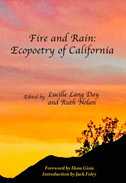
 |
Fire and Rain: Ecopoetry of California
by Lucille Lang Day, ed. and Ruth Nolan, ed.
Scarlet Tanager Books
An ode to California’s majestic inheritance when it comes to Mother Nature, this anthology presents one of the rare occurrences in which the spotlight is almost entirely removed from the poets themselves and placed onto the different natural gems that the Golden State offers. Letting your work stand for a greater cause takes both grace and humility. More importantly, the compilation expresses a dichotomy of concern and hope throughout by juxtaposing the awe-inspiring descriptions and imagery with the potential devastation that is in store for future generations.
With the compilation separated by places and habitats, from the coast and redwoods to the canyons, deserts, and beyond, audiences will get an opportunity to simultaneously be mesmerized and gauge the danger level faced by each. From a stylistic perspective, it is apparent that the editors have carefully scoped out poems that are both a strong representation of poetry and an articulation of the two-sided reality of California’s natural treasures. In “Before the Oil Spill,” one of the earlier poems from the “Coast and Ocean” section, poet Kay Morgan reminisces on the joys of being a child at the beach and immediately presents the clashing image of the mother scrubbing tar off the child’s feet and belly. Similarly, the editors align particular poems to illustrate the contrast. In Jacob Minasian’s “Half-Moon Bay,” the reader is at ease, taking in the sensory detail and the calm of the ocean’s organisms going about their day that culminates with a “concert of fountains” presumably from a group of dolphins. Immediately in the next poem, “The Hungry Calf,” the heartbreak of human error is captured in the opening line: “excuses pluck another humpback from the sea.” Within the context of the poetry, the readers are being exposed to harrowing conditions of the oceans. For instance, in “Blue Whales,” the poem opens with the statement that “blue whales are out there somewhere,” a population that has been decimated from hundreds of thousands to a mere six thousand.
The command of literary devices and figurative language present in this anthology is second to none. In one particular standout poem, “Poem 22 from The Monarchs,” the redwood is personified as an ancient monarch, wise and impartial, willing to listen indiscriminately, be it to the “sorrow of the celibate fathers” or the “sorrow of the missionized tribes.” Whether it be visceral similes like “the redwood trees stand like sentinels on the lonely coast,” or the use of repetitive phrases like “in the land of wind and tinder” in Stephanie Noble’s poem, the collection has no shortage of poetic technique to further emphasize the message. As with the coastal oceans, there are numerous “wake-up call” poems such as Timothy Houghton’s “Redwoods: Northern California,” where we are alerted to there being only four percent of the redwoods standing resolute.
More than anything else, this anthology is a time machine; its ability to transport the reader into different habitats and make the reader feel as though he could touch, see, smell, hear, and feel the entire experience is highly commendable. Its charm is in its relatability because, at one point or another, nearly every individual has found himself making or recalling memories in one of the places that this work focuses on. For instance, Richard Michael Levine’s “Turning 70 at a B&B on Clear Lake” demonstrates the essence of nature being a backdrop, a mostly silent spectator to all of life’s momentous occasions. The editors’ choices in the compilation collectively make the reader feel vibrant and alive while getting a taste of what the death of California’s natural gems would entail.
In the final section, “Cities, Towns, and Roads,” the poems present a compelling argument: these natural habitats have gradually made their way into our cities, and our actions can potentially lead to our own undoing. “Brentwood Coyotes,” for one, is a poem that is emblematic of the impending clash between nature and man-made society. The beauty provided by nature comes with inherent risks of natural disasters in the form of earthquakes, fires, floods, etc. With climate change being such a central topic to our existence now and into the future, many of the poems speculate on why we, as a society, are making it even more difficult through the manner in which we process our environment. Overall, this anthology combines spectacular poetry with a deluge of genuine passion for the environment and its preservation. For poetry aficionados and environmental enthusiasts alike, it would only be fitting for this work to be a must-read.
RECOMMENDED by the US Review